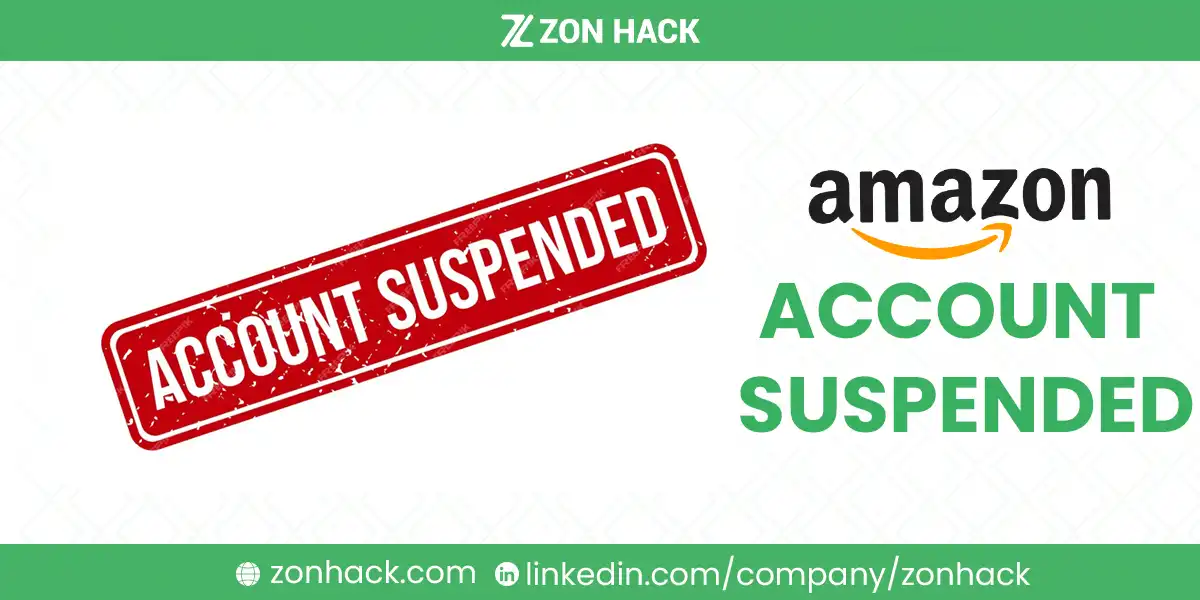Having your newly created Amazon account suspended can be a frustrating experience. Whether you’re a new seller or a buyer, seeing that suspension notice after taking the time to set up an account is unsettling. But don’t worry! Most account suspensions are reversible, and understanding why your account was suspended and how to resolve the issue can put you back on track quickly.
Amazon suspends accounts to protect the platform’s integrity, ensuring that rules are followed by everyone involved. In this article, we’ll talk about the reasons for Amazon suspending newly created accounts, how to resolve these suspensions, and steps to prevent it from happening again.
Why Do Newly Created Amazon Accounts Get Suspended?
Newly created Amazon accounts can be suspended for several reasons, ranging from policy violations to simple mistakes in account details. Understanding the underlying cause is the first step to resolving the issue. Let’s explore the common reasons:
Violating Amazon’s Terms of Service (TOS)
Amazon enforces strict terms of service, and violations of these rules are one of the leading causes of account suspensions. The Terms of Service outline acceptable behavior for both sellers and buyers and breaching them will quickly result in suspension.
Selling Prohibited Items
Another common violation is selling prohibited items. These include items such as weapons, drugs, counterfeit goods, or other restricted items. Amazon maintains a comprehensive list of banned products that all sellers must adhere to, and ignoring this list can result in immediate suspension.
Fraudulent Activities
Engaging in fraudulent activities is another reason for suspension. This can include creating fake accounts, manipulating reviews, or conducting inauthentic transactions. For instance, if Amazon’s algorithm detects that you’ve been involved in false purchases or fake reviews to inflate product ratings, it will flag and suspend your account.
IP Infringement
Another common issue is intellectual property infringement. Selling products that violate copyrights, patents, or trademarks without proper authorization can lead to account suspension. Before listing products, it’s critical to ensure that you have the legal right to sell them. For example, reselling unauthorized merchandise from well-known brands will likely result in IP-related suspension.
Can Suspicious or Automated Behavior Lead to Suspension?
Yes, Amazon monitors accounts for suspicious or automated behavior, especially when a new account behaves in ways that seem irregular. Amazon’s detection systems flag accounts that exhibit behaviors like using automated tools to list products or adjust prices. These activities can appear robotic or scripted, which violates Amazon’s policies.
For example, sellers using automation software that mass-lists products, changes prices too frequently, or automates reviews can get their account suspended. Similarly, buyers who place an unusually large number of orders right after creating an account may also trigger a suspension due to suspicious activity.
Does Incorrect or Incomplete Account Information Trigger Suspensions?
One of the easiest mistakes to make, yet one that can quickly result in suspension, is providing incorrect or incomplete information during account setup. Amazon verifies account details, and inconsistent or inaccurate data—such as mismatched billing addresses, incorrect phone numbers, or misspelled names—can lead to account suspension.
Imagine registering an account using a billing address that doesn’t match your payment method or inputting a name different from what is on your official ID. This discrepancy might flag your account as suspicious, leading to immediate suspension.
Does Amazon’s Risk Assessment Lead to Account Suspension?
Amazon uses a sophisticated risk assessment system to monitor new accounts. This system evaluates various factors like geographic location, IP address, transaction history, and behavior patterns. Accounts flagged as high-risk may be suspended even if no clear violation has occurred.
For example, if you share an IP address with a previously suspended account or live in a region that Amazon considers high-risk for fraud, your newly created account might be under higher scrutiny. Additionally, accounts that exhibit rapid activity shortly after creation—like adding many products for sale or placing high volumes of orders—may trigger Amazon’s risk algorithms and result in suspension.
How Can You Resolve a Suspension of Your Newly Created Amazon Account?
If your account gets suspended, there are clear steps you can take to resolve the issue. While it can seem overwhelming, knowing what to do can significantly speed up the reinstatement process.
- Review the Suspension Notification
The first thing you need to do is carefully review the suspension notification sent by Amazon. This email will outline the reasons for the suspension and provide any instructions for submitting an appeal. It’s crucial to thoroughly understand what caused the suspension before moving forward with your response.
- Submit a Strong Appeal
Submitting a strong appeal is the most effective way to get your account reinstated. Start by acknowledging the issue in the appeal letter and provide a detailed explanation addressing the specific reason Amazon gave for the suspension.
Here’s a simple outline for crafting your appeal:
- Clearly state that you understand the issue.
- Provide evidence to support your claims—such as invoices, government IDs, or proof of address.
- Outline a plan of action to ensure that the issue won’t happen again. This shows Amazon that you’re serious about following their guidelines.
Amazon takes appeals seriously, and responding with professionalism and clarity improves your chances of getting the suspension lifted. In 2022, a study found that 72% of sellers who submitted a well-documented appeal were able to reinstate their accounts within 14 days.
3. Contact Amazon Customer Service for Additional Help
If you need additional help, Amazon Customer Service can be a great resource. You can reach out through Seller Central (for sellers) or Amazon’s general customer service channels. Providing them with clear and concise information about your situation will allow them to offer specific guidance, sometimes speeding up the process.
How Long Does It Typically Take for Amazon to Reopen a Suspended Account?
On average, Amazon resolves suspensions within 10 to 30 days, depending on the complexity of the case and how quickly the user responds with the required information. While some issues can be resolved in a matter of days, others—especially those involving policy violations—may take longer to review.
What Can You Do to Prevent Future Suspensions?
Preventing future suspensions requires staying proactive and maintaining a healthy account. Here’s how you can do that:
- Stick to Amazon’s Policies
For sellers, sticking to Amazon’s policies is the key. Avoid selling prohibited or restricted items, ensure your product listings are accurate, and refrain from manipulating reviews or sales figures. It’s also important to keep your account information up to date to avoid any discrepancies during verification checks.
For buyers, maintaining a normal purchase pattern and avoiding suspicious behaviors—like making bulk orders right after creating an account—can help you avoid getting flagged.
- Provide Accurate and Complete Information
Providing accurate and complete information during account setup is essential. Double-checking your billing address, phone number, and other details before submitting your account will minimize the chance of suspension due to incorrect data.
- Always Follow Amazon Best Practices
Whether you’re a seller or buyer, following best practices is the best way to maintain a good account standing. This includes adhering to all of Amazon’s policies, keeping your account information current, and handling any potential issues (like returns or disputes) in a timely manner.
For sellers, establishing a strong reputation through consistent customer service and positive reviews will lower the risk of suspension. Preventive measures, such as monitoring your seller metrics and regularly reviewing Amazon’s updated policies, can further safeguard your account.
Frequently Asked Questions (FAQ)
1. Can I open a new Amazon account after my original one is suspended?
Amazon’s policies explicitly prohibit creating a new account while an existing one is suspended. Your best course of action is to resolve the suspension of your original account rather than opening a new one.
2. How long will it take to appeal and get my account reinstated?
Typically, Amazon resolves suspensions within 10-30 days, but this can vary depending on the reason for suspension and how quickly you provide the required information.
3. Is there a way to avoid suspension altogether?
Yes, by following Amazon’s policies, providing accurate information, and avoiding suspicious behaviors like automated activity, you can significantly reduce the risk of suspension.
4. What if my appeal is rejected?
If your appeal is rejected, carefully review the feedback from Amazon, make the necessary adjustments, and resubmit your appeal. You can also consider reaching out to Amazon’s support team for more specific guidance.
5. Can I sell on other platforms if my Amazon account is suspended?
Yes, other platforms such as eBay, Etsy, or Walmart Marketplace are alternatives. However, each platform has its own rules and regulations, so make sure to familiarize yourself with their policies before selling.
Summary
Getting your newly created Amazon account suspended can be frustrating, but it’s not the end of the road. By understanding why suspensions happen, following the right steps to appeal, and implementing best practices to prevent future issues, you can regain access to your account and continue your journey on Amazon. Being proactive, thorough, and compliant is key to long-term success on the platform.




